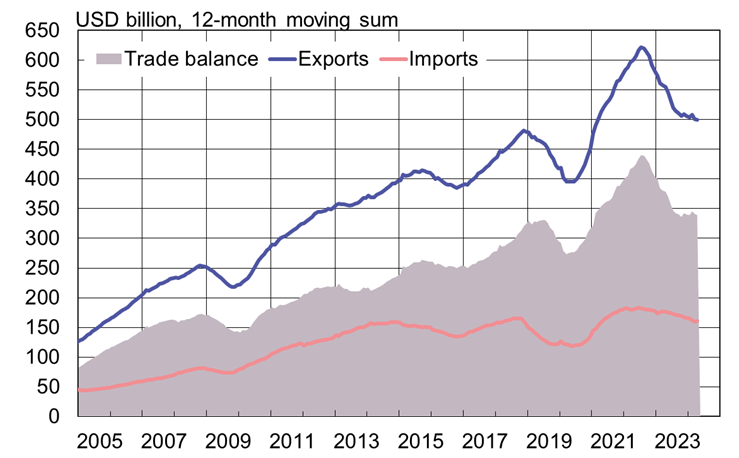BOFIT Weekly Review 20/2024
United States imposes new tariffs on Chinese products
On Tuesday (May 14), US president Joe Biden ordered the Office of the US Trade Representative to impose or increase tariffs on a range of Chinese products. The long list of new tariffs includes an increase from 0–7.5 % on certain steel and aluminium goods to 25 % this year and hikes in semiconductor tariffs from 25 % to 50 % by the end 2025. The directive also raises tariffs on electrical vehicles (EVs) from 25 % to 100 % in 2024, lithium batteries used in EVs and battery parts from 7.5 % to 25 % in 2024, lithium ion non-EV batteries from 7.5 % to 25 % in 2026, natural graphite and permanent magnets from 0 % to 25 % in 2026, certain critical minerals from 0 % to 25 % in 2024, solar panels from 25 % to 50 % in 2024, ship-to-shore cranes from 0 % to 25 %, syringes and needles from 0 % to 50 % in 2024, as well as personal protective equipment such as face masks from 0–7.5 % to 25 % in 2024 and latex gloves from 7.5 % to 25 % in 2026.
Despite the lengthy list of new tariffs, the value of listed products imported from China last year only amounted to 18 billion dollars, or about 4 % of US imports from China. For example, only a small number of Chinese EVs were imported to the US last year. In familiar fashion, China announced its vigorous opposition to the new tariffs and said that it would initiate measures to protect its own interests (although the proposed countermeasures had yet to be specified as of Friday morning). According to China Customs, the country’s goods exports to the US last year amounted to 506 billion dollars (15 % share of total exports) and imports 166 billion dollars (6 % of total imports). Exports have fallen since their historical peak in 2022 during the Covid-19 pandemic.
The US has recently stepped up other anti-China measures. On May 7, the US revoked several export licences for certain Intel and Qualcomm microchips to China’s Huawei. US state subsidies to domestic microchip producers (CHIPS for America Act of 2022) have also substantially increased investment in the field. In April, the US passed a divestment-or-ban bill forbidding the use of the Chinese social media app TikTok in the US unless TikTok’s Chinese owner ByteDance divests its US service. Upon Biden’s signing of the bill, ByteDance filed for a preliminary injunction in federal court challenging the law’s constitutionality.
All tariffs imposed on Chinese products by former president Donald Trump, as well as all counter tariffs imposed by China on US goods, remain in force. While the tariffs have harmed bilateral trade, studies indicate that goods are increasingly flowing between the two countries but the value chains now incorporate third counties such as Mexico or Vietnam to avoid higher tariffs. Notably, manufacturing value chains in the US have only increased the use of Chinese value added (BOFIT Policy Brief 14/2023). To some extent, the new tariffs merely reflect US domestic politics. The US presidential election takes place in just six months and anti-China measures enjoy broad support among voters.
China-US bilateral trade has declined from the historical highs in 2022
Sources: China Customs, Macrobond and BOFIT.